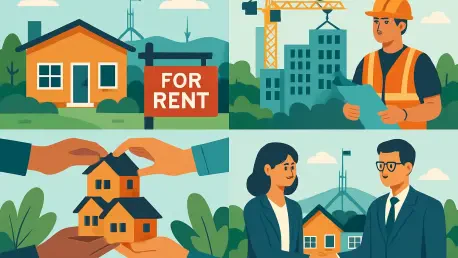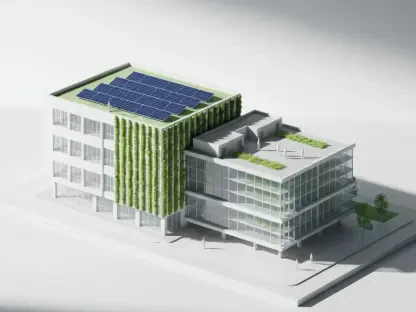Canberra, the capital city of Australia, is grappling with a concerning decline in its housing construction pipeline, sparking debates over potential solutions to address this crisis. According to recent data, an alarming decrease in home completions and building starts has been recorded, significantly impacting the construction industry and raising questions about the feasibility of ongoing and future projects. As the city strives to meet ambitious housing targets, the situation necessitates a comprehensive understanding of the challenges and the evaluation of alternative solutions, such as the possible introduction of a government-owned housing developer.
The Current Housing Construction Scenario
Alarming Statistics in Construction Activity
The statistics provided by the Australian Bureau of Statistics for the March quarter illustrate a severe downturn in Canberra’s housing sector. There was a precipitous drop in home completions, decreasing from 1,278 in the previous quarter to just 714. Concurrently, building starts fell by a striking 40 percent, shrinking from 717 to 427 homes. This sharp reduction in activity has prompted significant unrest among builders and developers, as it casts doubt on the viability of fulfilling housing projects under existing conditions. The figures corroborate industry claims about the challenging environment for new builds, which is hampered by financial and regulatory hurdles.
Ashlee Berry, serving as the executive director of Property Council ACT & Capital Region, emphasized that approvals and commencements were markedly down. Berry criticized the recent ACT Budget, noting how rising rates and land taxes are deterring developers and causing projects to stall or be canceled altogether. The removal of differential rates, coupled with persistent increases in commercial and residential rates, has contributed to an unviable atmosphere for many housing projects. Berry highlighted the trend of bracket creep and cost layering as elements intensifying the financial strains faced by developers in the region.
Factors Impacting Construction Feasibility
The narrative is further complicated by challenges highlighted by Anna Neelagama, CEO of Master Builders ACT, who pointed out that while national building activity shows signs of recovery, the ACT is facing a decline, which presents a cause for concern. Neelagama identified key obstacles such as low consumer confidence, prolonged planning approval processes, lengthy build times, outdated planning systems, and an increase in bureaucratic hurdles. Additionally, a chronic shortage of skilled labor and rising regulatory demands are contributing to sluggish productivity and delayed project completions.
While acknowledging recent initiatives by the ACT Government to address these issues, Neelagama underscored the need for more decisive action to restore the construction sector’s trajectory. The growing regulatory burden has created an environment that hinders timely completion of builds, thereby frustrating efforts to meet housing demand. The cumulative effect of these factors is a stifled construction industry struggling to meet its goals and the growing needs of a city steadily expanding in population and housing requirements.
Propositions for Solutions
ACT Greens’ Proposal for a Public Developer
Amidst the growing concerns, the ACT Greens have proposed an innovative approach, advocating for the establishment of a government-owned housing developer. Party leader Shane Rattenbury has championed this concept as a strategic solution to address pressing issues like labor shortages and the scarcity of affordable housing. Drawing on experiences from other regional initiatives, Rattenbury argues that a public developer could secure a steady flow of public build projects, ensuring reliable employment for tradespeople while delivering affordable housing options for those on lower wages.
This proposal aims to establish a consistent project pipeline, providing long-term job security for workers in the construction sector. The creation of a publicly operated entity could help stabilize the housing market, making it more resilient to economic fluctuations. The Greens’ proposition emphasizes the need for innovative strategies to overcome barriers that have hindered private sector-led housing initiatives, suggesting that a combined effort from public and private sectors could lead to more sustainable development outcomes.
Government’s Assurance of a Robust Pipeline
Contrasting the concerns raised by builders and ACT Greens, the ACT Government asserts that the housing construction pipeline remains robust and capable of addressing the region’s needs. A government spokesperson highlighted their strategic initiatives, including a substantial $145 million budget commitment to develop the future construction workforce. This includes increased training subsidies for vital trades like carpentry and plumbing. Such investments are designed to alleviate immediate capacity constraints and stimulate growth in housing construction.
The spokesperson also pointed to development application data, indicating an increase in applications lodged in the recent quarter compared to the previous period. Notably, single residential project applications have seen a significant rise, with June 2025 marking the highest number for the current financial year. As interest rates and capacity constraints ease, the government remains optimistic about the construction sector’s recovery, anticipating a renewed surge in building activity aligning with real wage growth and expanding population demands.
Future Implications and Considerations
Addressing Labor and Project Challenges
A draft report from Pegasus Economics warned of potential labor shortages thwarting Canberra’s housing ambitions, predicting that housing approvals may continue to fall below expected numbers. These findings underscore the need for ongoing attention to workforce development and innovative delivery models. Striking a balance between regulatory compliance and efficiency will be crucial to overcoming the challenges outlined by industry stakeholders, ensuring projects are not just initiated but completed within designated timelines.
Both industry leaders and government officials acknowledge the necessity of a collaborative approach to bolster confidence and facilitate the successful delivery of housing projects. As Canberra aims to construct 30,000 new homes by 2030, addressing labor shortages and fostering an environment conducive to innovation will be key. Streamlining approval processes and re-evaluating rate structures could further enhance project feasibility, enabling stakeholders to meet evolving demands effectively.
Building a Sustainable Housing Sector
Canberra, the capital of Australia, is currently facing a significant challenge with a sharp decline in its housing construction pipeline. This situation has ignited discussions on potential strategies to tackle this growing issue. Recent statistics reveal a concerning drop in both home completions and new building starts, which has taken a toll on the construction industry. This downturn raises serious doubts about the viability of existing and future projects. As Canberra aims to meet its ambitious housing goals, it must gain a thorough understanding of the obstacles it faces and explore alternative solutions. One such option might be creating a government-owned housing developer to help alleviate the crisis. The city’s focus includes ensuring affordability, enhancing infrastructure, and streamlining planning processes. Engaging key stakeholders, including builders, developers, and policymakers, becomes crucial in reimagining strategies to revitalize the housing sector and align with the community’s needs and growth expectations.









